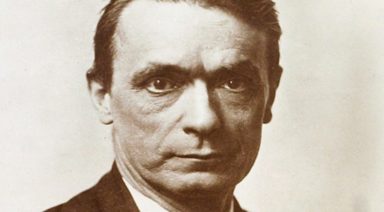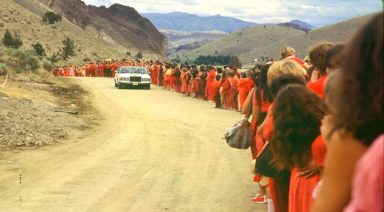The Hero’s Journey: Joseph Campbell Now More Relevant Than Ever

Making sense of our consciousness can be difficult, and in our materialist, western world we try endlessly to objectify that experience. But over the course of the past century, there have been a number of intermediaries reminding us to reconnect with elements of the spiritual journey.
Names like Alan Watts, Thich Nhat Hanh, and Deepak Chopra have sparked a renaissance of interest in the nature of consciousness, meditation, and mindfulness. They remind us of stories and lessons learned over the course of our history, and within these, we find recurring themes of transcendent truth.
But there is one liaison between the old world and the new, who bridged these philosophies and connected the ancient esotericism of the east to the pragmatism of the scientific west, through archetypes and allegory.
Joseph Campbell defined this thirst for truth over a lifetime by examining artists, psychologists, writers, and philosophers. He referred to the lessons in their mythos as the Masks of God, and the protagonists within those stories as the Hero with a Thousand Faces.
Campbell consumed as much of their wisdom as possible, voraciously reading nine hours a day for years at a time. He absorbed the work of great western minds like Carl Jung, Pablo Picasso, James Joyce, and Sinclair Lewis. Through these lessons, he connected the dots of contemporary consciousness with the timeless teachings of the Bhagavad Gita, the Bible, Greek mythology, and the Tibetan Book of the Dead.
In those years of study, he found lessons that applied to man and society at large – overarching narratives that struck a universal chord, particularly the sense that at some point in our lives, we find there is a call unanswered, a void in the spirit that must be fulfilled.
“Follow your bliss and the universe will open doors for you where there were only walls. The cave you fear to enter holds the treasure you seek.”
– Joseph Campbell
The Hero’s Journey
Campbell said you can never be at peace with yourself if you do not answer that call. The call to adventure that forces the hero to remove himself from the ordinary world and face whatever it is that threatens his safety, comfort, and way of life.
At first, the call is refused when fears and second thoughts arise, or the comforts of the home seem too difficult to abandon. But eventually, the hero finds a mentor who pushes them and provides the tools needed to confront their tribulation.
When one considers the “Hero’s Journey,” Luke Skywalker, Arjuna, or even Hamlet could fit the role, but these stereotypes are meant to convey a general truth about finding the fulfillment we all seek. The personal ordeals that confront us can be difficult to face, causing us to relinquish a part of ourselves and take solace in a place that feels safe, while we remain oblivious to what could be learned by challenging those fears.
For some, it may be a vice; an addiction that keeps us trapped in some behavior or lifestyle. Campbell looked to the Tibetan Book of the Dead to confront this type of ordeal, learning that the scripture taught one to strive for the opposing virtue of whatever your vice may be; to overcome what he called the “inmost cave.” By cultivating the antithesis of your vice, you will find the self-actualization that defines your being.
This sentiment has been echoed many times over the ages, and Campbell summed it up when he said, “Gods suppressed become devils, and often it is these devils whom we first encounter when we turn inward.”
Campbell’s Exploration of Jungian Archetypes in Mythology
Campbell’s study of psychology often led to the examination of Jungian archetypes; the highly developed elements of the collective unconscious seen indirectly in myth. These recurrent characters are the hero who wears a thousand masks, representing different facets of the individual psyche, as well as the world at large.
In Navajo lore, the archetype of the coyote is often depicted as a cunning, greedy, and foolish trickster; a caricature of the shaman, who was said to be able to fly by connecting with God. The coyote on the other hand, attempts to literally fly, transcending his mortal fate and failing miserably – sound familiar?
Campbell would reference his colleague Heinrich Zimmer when connecting ancient archetypes to these truths, saying the best things in life transcend thought. “The second best are misunderstood, because those are the thoughts that are supposed to refer to that which can’t be thought about, and one gets stuck with the thoughts,” he said. “The third best are what we talk about, you see. And myth is that field of reference, metaphors referring to what is absolutely transcendent.”
Campbell learned that the western world has lost the power of myth, and in our quest to find life’s meaning we may be missing the point. Instead of seeking the objective meaning of life, we’re actually seeking the experience of being alive, so that it vibrates with our inner being – something which has been lost in modern society’s materialism.
“And the myth, the only myth that’s going to be worth thinking about in the immediate future is one that’s talking about the planet. Not this city, not these people, but the planet and everybody on it,” Campbell said, “…how to relate this society to the world of nature and the cosmos. That’s what the myths have all talked about; that’s what this one’s got to talk about. But the society that it’s going to talk about is the society of the planet, and until that gets going, you don’t have anything.”
In our modern age, it’s easy to seek an anodyne lifestyle – avoiding pain, while seeking simple pleasures through modes of instant gratification. Technology provides a quick solution for everything, putting us in passive states of consumption to take our minds off the struggles and inequality rampant in the world.
No wonder there’s such interest in yogic practice, meditation, and ancient philosophy; we’ve been given the call to adventure, but we’re in Campbell’s third stage of the Hero’s Journey: refusal of the call.
But the mentor we seek is right in front of us, waiting to be embraced, waiting to help us cross the threshold and approach the inmost cave. To put into action those transformational principles we know to be true in our hearts.
There, we can face our biggest ordeal to reach the apotheosis, seize the sword, and return with the elixir. There’s a hero in us all, don’t wait to start your journey.
Rudolf Steiner: A Soul In Love With Life

Philosopher. Educator. Architect. Esoteric. Spiritual Scientist. Rudolf Steiner was each of these and more — a man of multitudes, embracing the deeply scientific, as well as the higher realms of mystics. Considered an innovator and disrupter of traditional ideas, Steiner’s original thinking helped shape modern medicine, sustainable agriculture and economics, body-centered arts, spirituality, and holistic education. Many believe Steiner was one of the most “spiritually gifted and accomplished figures of the 20th century,” inspiring generations to achieve our highest human potential.
EARLY LIFE AND INFLUENCES
Born in 1861, Rudolf Steiner began his life in Pottschach, nestled in the lower Austrian Alps. Jonathan Stadall’s documentary, The Life of Rudolf Steiner, provides insight into Steiner’s formative years, ones in which he was free to explore nature while exposed to the power of the railway, where his father was stationmaster. This juxtaposition of nature and science shaped Steiner as he worked to find a bridge between the two.





































